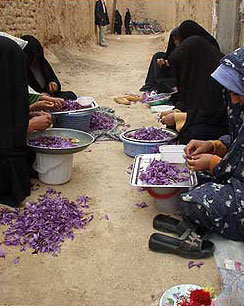Human Flower Project
Wednesday, November 15, 2006
Iran’s Saffron Ambitions
With 96% of the world market, Iran’s spice industry is still struggling.

Iranian saffron
Photo: The Poster
Enough about the Iranian nuclear program. What this country really needs is a saffron strategy, a plan for turning its position as the world’s #1 spice-crocus grower into profits for Iranian people.
Iran now produces 96% of the world’s saffron, and both output and demand are on the rise. Iran Mania reports “Ten years ago a mere 32 tonnes of saffron was exported from Iran while last year 200 tonnes went abroad out of a total output of 230 tonnes, bringing in 100 million dollars worth of revenue.”
To produce one pound of saffron takes 75,000 crocus sativus linneaus blooms; the flower stigmas dry into crinkly orange-yellow particles, fragrant and savory, and one of the most costly spices in the world.
A near monopoly, high prices, and a growing market would seem the perfect formula for bulging pockets, but not so. Iran is stuck in a production-only mode and fails to benefit from the wider margins that accrue to packagers.
“’If we sold in packaging, the Europeans would make less of a profit,’ said Mohammad Hossein Meshkani, head of Iran’s saffron cooperatives…”If we stop selling in bulk we can make a profit here and export it. But there should be a national will for it. It is not something that can only come from me.’”
In other words, Iran needs a coherent saffron policy. People here have been growing and harvesting crocus stigma for 3000 years but the packing industry is new; it needs government’s kick-start.
 Women in Iran remove the stigmas
Women in Iran remove the stigmas
from crocus flowers, for saffron
Photo: AFP via Iran Mania
The Iran Mania article gives an interesting look at Torbat-e Heydarieh’s autumn market, where nearly 800,000 growers, pickers, threaders (who remove the stigmas) and traders hustle for the two month season. This is a tough year. Drought in Iran has lowered the 2006 saffron yield. There are old competitors, like Kashmir, and new ones, too—upstarts Greece, Italy and Spain have been vying for a bigger share of global sales.
Last month, Iran hosted a saffron symposium in Mashhad, where an international group of experts gathered to discuss biotechnology, trade, and packaging, too.
Something tells us that the women hired to pull the stigmas out of crocus flowers aren’t striking it rich (actually, women workers seem to power the few existing packaging factories, too). Even so, Iranian producers are looking warily to the east. Iranian crocus seed, they say, has been smuggled into neighboring Afghanistan. Water is more plentiful there, and labor even cheaper.




